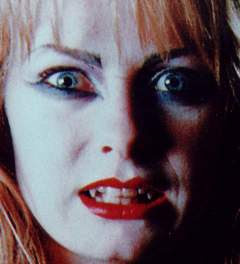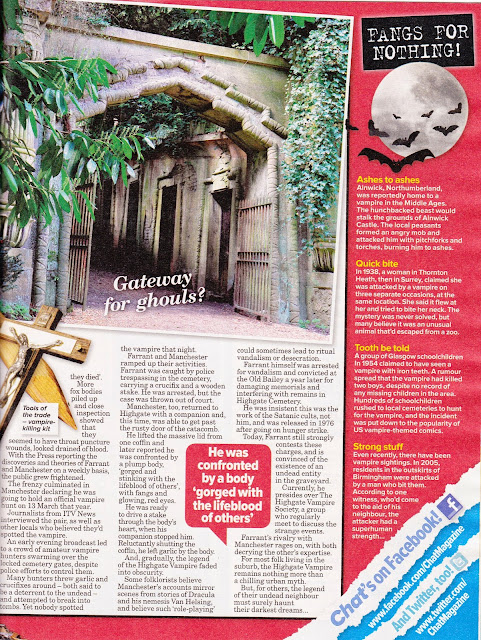The word vampire in the English language was borrowed (perhaps via French vampyre) from German wampyr, in turn borrowed in early 18th century from Serbian вампир/vampir or, according to some sources, from Hungarian vámpír. The Serbian and Hungarian forms have parallels in virtually all Slavic languages: Bulgarian вампир (vampir), вапир (vapir) or въпир (vəpir), Croatian vampir, Czech and Slovak upír, Polish wąpierz and (perhaps East Slavic-influenced) upiór, Russian упырь (upyr'), Belarussian упiр (upyr), Ukrainian упирь (upir' ), from Old Russian упирь (upir'). The etymology is uncertain. Among the proposed proto-Slavic forms are ǫpyr and ǫpir. The Slavic word might, like its possible Russian cognate netopyr ("bat"), come from the Proto-Indo-European root for "to fly". Another theory has it that the Slavic word comes from a Turkic word denoting an evil supernatural entity (cf. Kazan Tatar ubyr "witch"). This theory has now become obsolete, but has recently been embraced by one Polish scholar. The word Upir as a term for vampire is found for the first time in written form in 1047 in a letter to a Novgorodian prince referring to him as "Upir Lichyj" (Wicked Vampire or Foul Vampire).
Tales of the undead craving blood are ancient and found in nearly every culture around the world. Vampire-like spirits called the Lilu are mentioned in early Babylonian demonology, and the bloodsucking Akhkharu even earlier in the Sumerian mythology. These female demons were said to roam during the hours of darkness, hunting and killing newborn babies and pregnant women. One of these demons, named Lilitu, was later adapted into Jewish demonology as Lilith. Lilitu/Lilith is sometimes called the mother of all vampires.
In India, tales of the Vetalas, ghoul-like beings that inhabit corpses, are found in old Sanskrit folklore. A prominent story tells of King Vikramāditya and his nightly quests to capture an elusive Vetala. The stories of the Vetala have been compiled in the book Baital Pachisi.
The Ancient Egyptian goddess Sekhmet in one myth became full of bloodlust after slaughtering humans and was only sated after drinking alcohol coloured as blood.
In Homer's Odyssey, the shades that Odysseus meets on his journey to the underworld are lured to the blood of freshly sacrificed rams, a fact that Odysseus uses to his advantage to summon the shade of Tiresias. Roman tales describe the strix, a nocturnal bird that fed on human flesh and blood. The Roman strix is the source of the Romanian vampire, the Strigoi and the Albanian Shtriga, which also show Slavic influence.
In early Slavic folklore, a vampire drank blood, was afraid of (but could not be killed by) silver and could be dealt with by cutting off its head or by putting a wooden stake into its heart.
Medieval historians and chroniclers Walter Map and William of Newburgh recorded the earliest English stories of vampires in the twelfth century.
Many vampire legends also bear similarities to legends and religious beliefs regarding succubi or incubi.
The Oxford English Dictionary dates the first appearance of the word vampire in English from 1734, in a travelogue titled Travels of Three English Gentlemen published in the Harleian Miscellany in 1745. Vampires had already been discussed in German literature. After Austria gained control of northern Serbia and Oltenia in 1718, officials noted the local practice of exhuming bodies and "killing vampires." These reports, prepared between 1725 and 1732, received widespread publicity.
The English term could have been derived via French vampyre from the German wampyr, in turn thought to be derived in the early eighteenth century from the Serbian вампир/vampir. The Serbian form has parallels in virtually all Slavic languages: Bulgarian вампир (vampir), Czech and Slovak upír, Polish wąpierz, and (perhaps East Slavic-influenced) upiór, Russian упырь (upyr'), Belarusian упыр (upyr), Ukrainian упирь (upir'), from Old Russian упирь (upir'). Many of these languages have also borrowed forms such as "vampir/wampyr" subsequently from the West; these are distinct from the original local words for the creature. The exact etymology is unclear.
The first recorded use of the Old Russian form Упирь (Upir) is commonly believed to be in a document dated 6555 (1047 AD). It is a colophon in a manuscript of the Book of Psalms written by a priest who transcribed the book from Glagolitic into Cyrillic for the Novgorodian Prince Vladimir Yaroslavovich. The priest writes that his name is "Upir' Likhyi" (Упирь Лихый), which means "Foul Vampire".
Another early use of the Old Russian word is in the anti-pagan treatise Word of Saint Grigoriy, dated variously from the eleventh to the thirteenth centuries, where pagan worship of upyri is reported.
Upon discovery, a vampire can be exorcised by cremation, decapitation, exposure to sunlight and impalation with a stake through its heart. The vampire’s powers are many and varied. They can remain undead indefinitely unless exorcised in a specific manner. They can assume animal shapes and some have been thought to control the elements locally. Metamorphosis into mist is not unknown either. They can intrude upon sleeping persons’ dreams and mesmerise their prey. Their infectious bite may eventually result in the death of their victims, a small number of whom will likewise become undead upon apparent expiry. Vampires, despite their manifold supernatural abilities, are nevertheless not invulnerable. They leave the confines of where the corporeal shell resides only between sunset and sunrise. They cannot cross running water save at the slack or the flood of the tide. They fear and shrink from the sign of the cross, the crucifix and, above all, from the Host, the Body of God. Holy water will burn them as some scorching acid and they flee from the fragrance of most incense, particularly frankincense. Certain trees and herbs are hateful to them, especially whitethorn, or buckthorn. They are also curiously allergic to garlic. The pungent herb Allium Sativum (wild variety: Allium Vineal) is deemed to be effective as a vampire repellent. In 450 BC, Herodotus, the Greek historian, in Euterpe: Concerning the History of Europe, remarks about an inscription inside the Cheops pyramid at Gisa, built circa 2900 BC, that attests to the value of garlic’s arcane properties. It was invariably employed to ward off evil spirits, and still is.
Exorcism does not "kill" the demonic agent. It rids the supernatural predatory wraith from our sphere or dimension. The corporeal host obviously returns to its true state and is no longer plagued by the apparent supernatural ability to manifest as though it were living. During the exorcism the corporeal shell returns to earthly time as the demonic entity is expelled.
Evil tends to need to be invited when it enters a portal into our hemisphere. This does not necessarily require a full-blown evocation, or the raising of demons per se. It is relatively easy to release evil into the world for evil is not merely a lack of something, but an effective agent, a living spiritual being, perverted and perverting; a terrible reality: mysterious and frightening. The problem arises when attempting to cast such evil out of our world. This is significantly more difficult than inviting it in.
When disinterred the abnormal condition of the corpse will be a sure mark of whether it is a vampire or not. Such bodies do not suffer decomposition after burial. They do not fall to dust. Generally described as being exceedingly gaunt and lean with a hideous countenance, the vampire, when he has satiated his lust for warm human blood, will appear horribly puffed and bloated, as though he were some filthy leech, gorged and replete to bursting. The lips are often markedly full and drawn back to reveal sharp teeth, gleaming white against a frame stained with slab gouts of blood. The foul offal from the previous night's feast. The gaping mouth, stained and foul with blood, might reveal glutinous trickles that have spilled on to the lawn shrouding and linen cerements. The form is therefore discovered gorged and stinking with the life-force blood of others. The eyes are sometimes closed; more frequently open, glazed, fixed, and glaring fiercely. The corpse will nevertheless seem composed as if in a profound sleep. The stench of the charnel where these undead repose is oftentimes so terrible and fetid that the sickening odour can effect the senses of an observer for possibly months afterwards. Epidemics of this unspeakable evil have resulted in entire graves being discovered soaked and saturated with squelching blood. Such an epidemic plagued south east Europe and reached England's shores in the early part of the 18th century. It is believed that this is where the Highgate contamination has its origins.
It was necessary to tell the full story, even though this was not an easy decision, due to the overwhelming public interest in the case, but I really now feel the subject has been exhausted and all there is to say about it has been said. It has also exhausted me after decades of television and radio interviews, film documentaries and related projects concentrating on this one topic. There will always be people seeking to cash in and exploit my work for their own ends. Many, of course, will be too young to remember the happenings at Highgate. That notwithstanding, my book The Highgate Vampire is optioned for cinematic treatment, but that is not something I can elaborate upon here.
I am willing to quietly and privately set the record straight where need be, but I gave my final interview about this case to the broadcast media some years ago and have no intention of returning to the topic despite persistent requests from television and radio programmes for me to do so almost every week. I still make contributions on unrelated matters, but this subject of intense public fascination — in some cases obsession — concerning the events at Highgate Cemetery is not something I have an appetite to return to any longer. Having said that, my memoir in its unexpurgated form mentions the case in a proper and fitting context to the rest of my life. I have no plans to have this document published, however; now or ever.
Unimaginable horrors were experienced by folk at the time of the contagion and these I feel are best not evoked. They should be left undisturbed. The reality that I and others, most now sadly deceased, experienced all those many years ago no longer exists, and next to the hunger to experience the supernatural, albeit in this case at its most maleficent and deadly, there is perhaps no stronger hunger than to forget.
_________________________________________________________________________________
Nota Bene: You can order The Highgate Vampire by clicking on the image above.










































